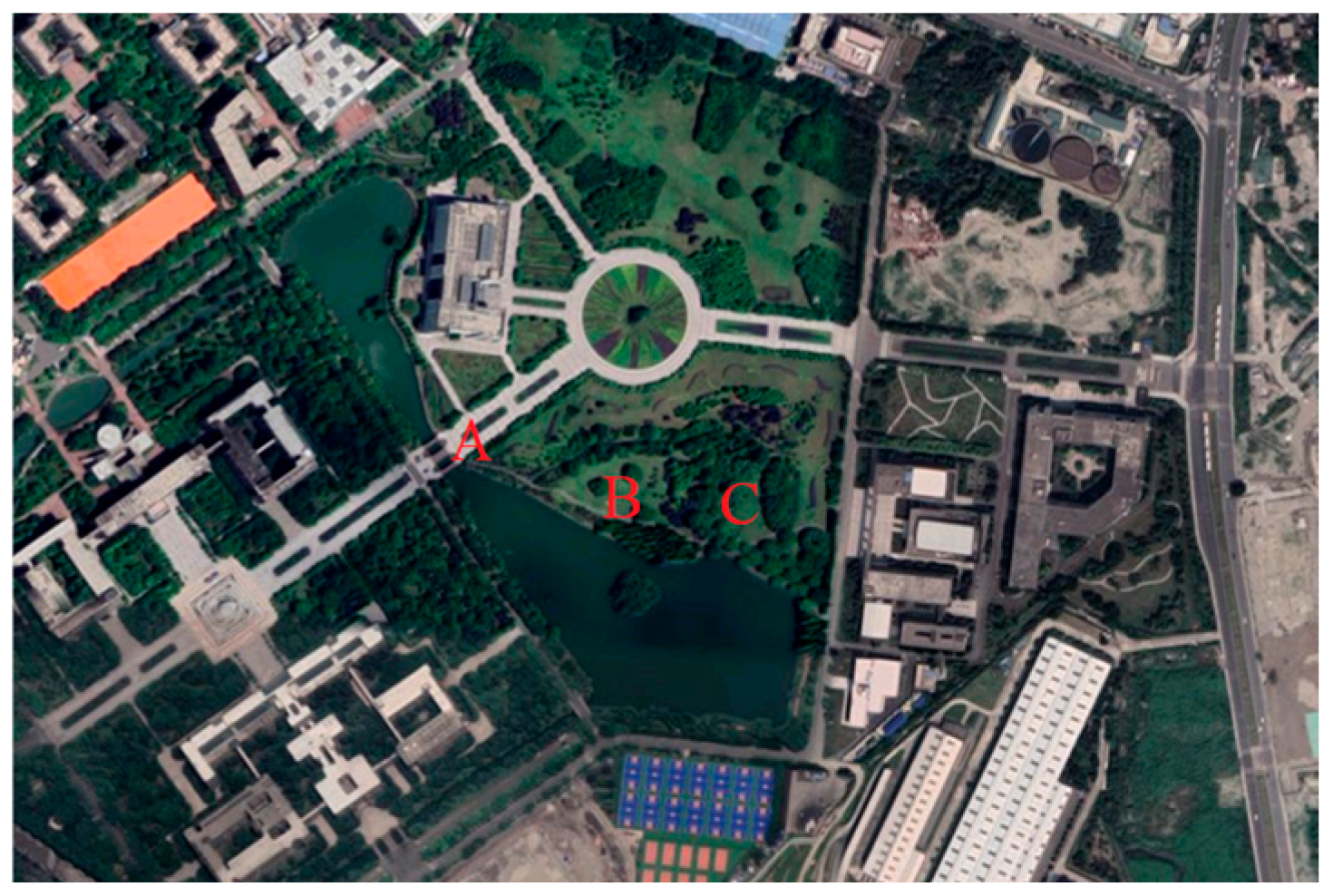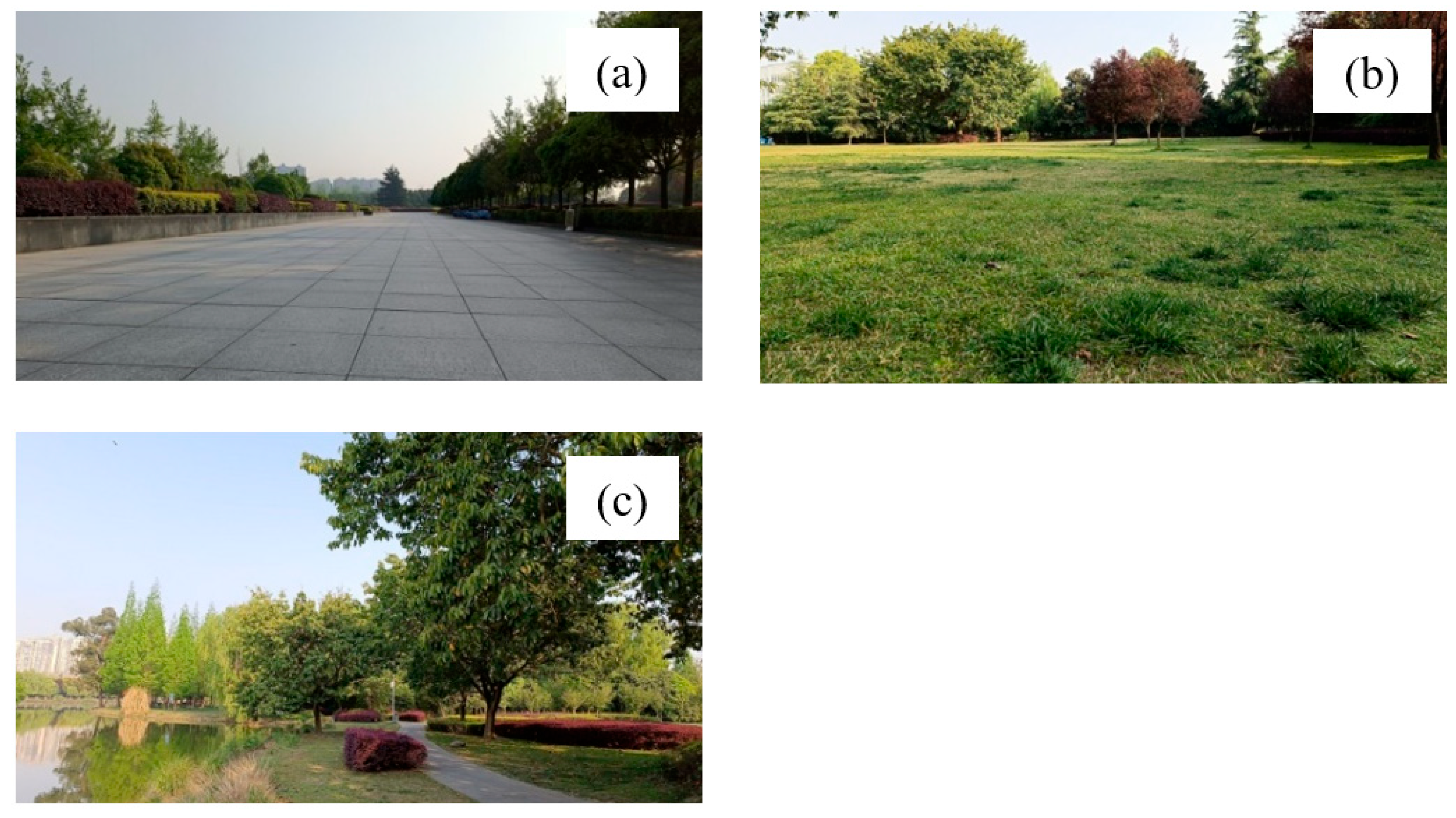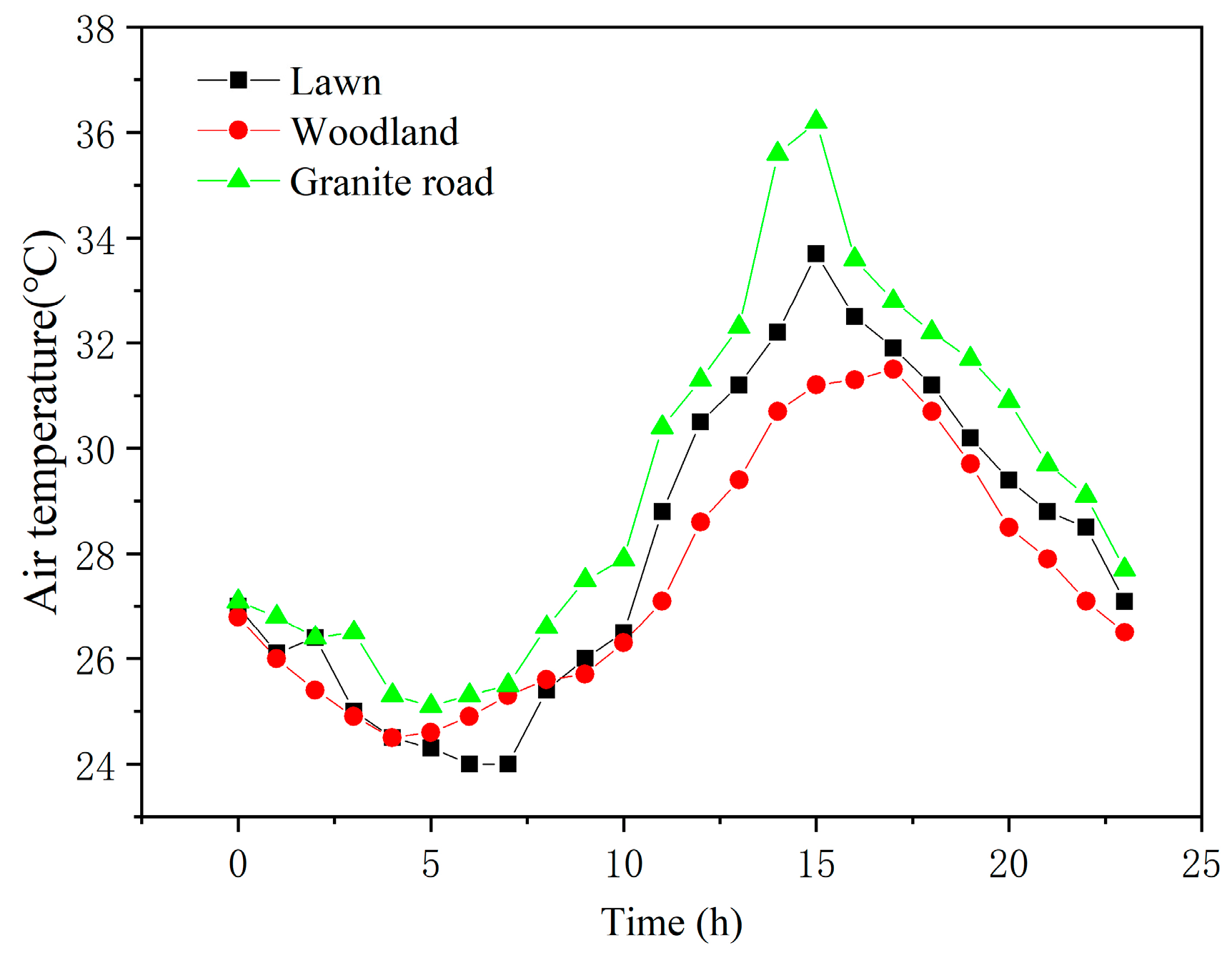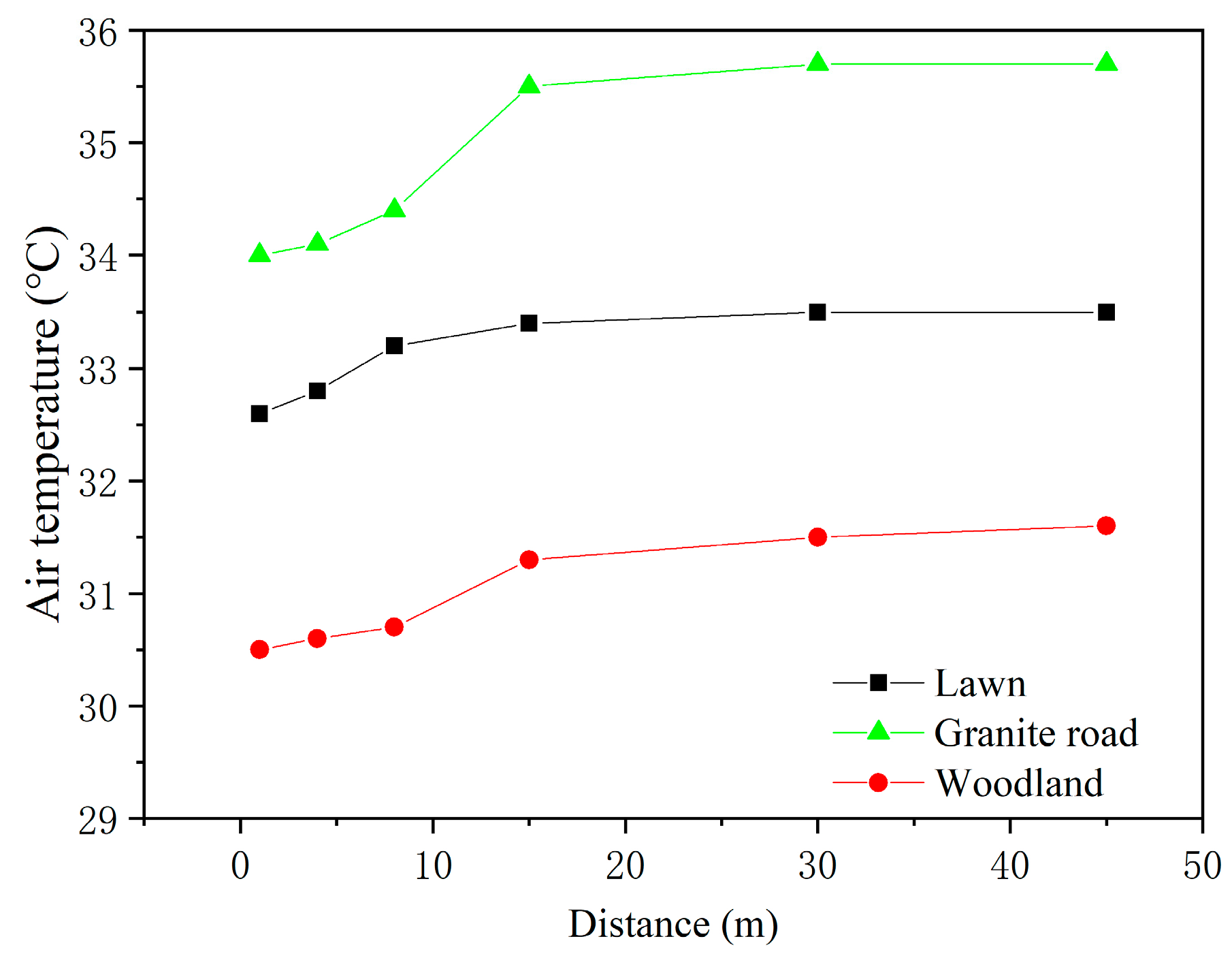Impacts of Small Lakes and Underlying Surface Characteristics on Local Thermal Environments in Summer
Abstract
1. Introduction
2. Study Area and Observations
2.1. Study Area
2.2. Data Sources
3. Results and Discussion
3.1. Change in Air Temperature Above Different Underlying Surfaces over Time
3.2. Change in Air Temperature Above Different Underlying Surfaces with Distance from Water
3.3. Change in Relative Humidity over Different Underlying Surfaces over Time
3.4. Change in Relative Humidity Above Different Underlying Surfaces with Distance from Water
4. Conclusions
- Granite roads exhibited significantly higher daytime air temperatures compared to lawns and woodlands. This disparity arises from the low albedo and specific heat capacity of granite, which prioritize sensible heat release over latent heat dissipation. In contrast, lawns and woodlands reduce the surrounding air temperature through plant transpiration.
- Small lakes demonstrated a pronounced cooling effect on their surroundings environment, reducing air temperatures by up to 2 °C within 30 m of their boundary. The cooling intensity diminished with distance from the shoreline, establishing a positive correlation between air temperature and distance to the lake. This spatial pattern underscores the lake’s role as a cooling island, primarily driven by evaporative cooling and heat absorption.
- Relative humidity exhibited a strong negative correlation with distance from the lake, declining most rapidly within the first 30 m. The lake’s humidifying effect was attributed to sustained evaporation, which enhanced water vapor concentrations near the waterfront.
Author Contributions
Funding
Data Availability Statement
Conflicts of Interest
References
- Luo, Z.; Liu, J.; Shao, W.; Zhou, J.; Jia, R. Distribution of dry and wet islands in the Pearl River Delta urban agglomeration using numerical simulations. Atmos. Res. 2022, 273, 106170. [Google Scholar] [CrossRef]
- Olah, A. The possibilities of decreasing the urban heat Island. Appl. Ecol. Environ. Res. 2012, 10, 173–183. [Google Scholar] [CrossRef]
- Zhang, H.; Yin, Y.; An, H.; Lei, J.; Li, M.; Song, J.; Han, W. Surface urban heat island and its relationship with land cover change in five urban agglomerations in China based on GEE. Environ. Sci. Pollut. Res. 2022, 29, 82271–82285. [Google Scholar] [CrossRef] [PubMed]
- Anjos, M.; Targino, A.C.; Krecl, P.; Oukawa, G.Y.; Braga, R.F. Analysis of the urban heat island under different synoptic patterns using local climate zones. Build. Environ. 2020, 185, 107268. [Google Scholar] [CrossRef]
- Hou, H.; Liu, K.; Li, X.; Chen, S.; Wang, W.; Rong, K. Assessing the urban heat island variations and its influencing mechanism in metropolitan areas of Pearl River Delta, South China. Phys. Chem. Earth 2020, 120, 102953. [Google Scholar] [CrossRef]
- Santamouris, M.; Cartalis, C.; Synnefa, A.; Kolokotsa, D. On the impact of urban heat island and global warming on the power demand and electricity consumption of buildings—A review. Energy Build. 2015, 98, 119–124. [Google Scholar] [CrossRef]
- Yang, X.; Peng, L.L.H.; Jiang, Z.; Chen, Y.; Yao, L.; He, Y.; Xu, T. Impact of urban heat island on energy demand in buildings: Local climate zones in Nanjing. Appl. Energy 2020, 260, 114279. [Google Scholar] [CrossRef]
- Hathway, E.A.; Sharples, S. The interaction of rivers and urban form in mitigating the Urban Heat Island effect: A UK case study. Build. Environ. 2012, 58, 14–22. [Google Scholar] [CrossRef]
- Moyer, A.N.; Hawkins, T.W. River effects on the heat island of a small urban area. Urban Clim. 2017, 21, 262–277. [Google Scholar] [CrossRef]
- Cai, Z.; Han, G.; Chen, M. Do water bodies play an important role in the relationship between urban form and land surface temperature? Sustain. Cities Soc. 2018, 39, 487–498. [Google Scholar] [CrossRef]
- Deng, Q.; Zhou, Z.; Li, C.; Yang, G. Influence of a railway station and the Yangtze River on the local urban thermal environment of a subtropical city. J. Asian Archit. Build. Eng. 2022, 21, 588–603. [Google Scholar] [CrossRef]
- Cruz, J.A.; Blanco, A.C.; Garcia, J.J.; Santos, J.A.; Moscoso, A.D. Evaluation of the cooling effect of green and blue spaces on urban microclimate through numerical simulation: A case study of Iloilo River Esplanade, Philippines. Sustain. Cities Soc. 2021, 74, 103184. [Google Scholar] [CrossRef]
- Steeneveld, G.J.; Koopmans, S.; Heusinkveld, B.G.; Theeuwes, N.E. Refreshing the role of open water surfaces on mitigating the maximum urban heat island effect. Landsc. Urban Plann. 2014, 121, 92–96. [Google Scholar] [CrossRef]
- Rising, H.H.; Deng, L. The effects of small Water Cool(ing) Islands on body temperature. J. Urban Des. 2024, 29, 167–183. [Google Scholar] [CrossRef]
- Norton, B.A.; Coutts, A.M.; Livesley, S.J.; Harris, R.J.; Hunter, A.M.; Williams, N.S.G. Planning for cooler cities: A framework to prioritise green infrastructure to mitigate high temperatures in urban landscapes. Landsc. Urban Plann. 2015, 134, 127–138. [Google Scholar] [CrossRef]
- Sun, R.; Chen, L. How can urban water bodies be designed for climate adaptation? Landsc. Urban Plann. 2012, 105, 27–33. [Google Scholar] [CrossRef]
- Robitu, M.; Inard, C.; Groleau, D.; Musy, M. Energy balance study of water ponds and its influence on building energy consumption. Build. Serv. Eng. Res. Technol. 2004, 25, 171–182. [Google Scholar]
- Du, H.; Song, X.; Jiang, H.; Kan, Z.; Wang, Z.; Cai, Y.J. Research on the cooling island effects of water body: A case study of Shanghai, China. Ecol. Indic. 2016, 67, 31–38. [Google Scholar] [CrossRef]
- Wu, J.; Li, C.; Zhang, X.; Zhao, Y.; Liang, J.; Wang, Z. Seasonal variations and main influencing factors of the water cooling islands effect in Shenzhen. Ecol. Indic. 2020, 117, 106699. [Google Scholar] [CrossRef]
- Sharma, K.; Kumar, V.; Gautam, L.; Choudhary, S.; Mathew, A. Geo-physical seasonal deviations of land use, terrain analysis, and water cooling effect on the surface temperature of Pune city. J. Water Clim. Chang. 2023, 14, 4802–4820. [Google Scholar] [CrossRef]
- Xu, J.; Wei, Q.; Huang, X.; Zhu, X.; Li, G. Evaluation of human thermal comfort near urban waterbody during summer. Build. Environ. 2010, 45, 1072–1080. [Google Scholar] [CrossRef]
- Jacobs, C.; Klok, L.; Bruse, M.; Cortesão, J.; Lenzholzer, S.; Kluck, J. Are urban water bodies really cooling? Urban Clim. 2020, 32, 100607. [Google Scholar] [CrossRef]
- Liu, Y. Dynamic evaluation on ecosystem service values of urban rivers and lakes: A case study of Nanchang City, China. Aquat. Ecosyst. Health Manag. 2014, 17, 161–170. [Google Scholar] [CrossRef]
- Hossu, C.A.; Iojă, I.-C.; Onose, D.A.; Niță, M.R.; Popa, A.-M.; Talabă, O.; Inostroza, L. Ecosystem services appreciation of urban lakes in Romania. Synergies and trade-offs between multiple users. Ecosyst. Serv. 2019, 37, 100937. [Google Scholar] [CrossRef]
- Reynaud, A.; Lanzanova, D. A Global Meta-Analysis of the Value of Ecosystem Services Provided by Lakes. Ecol. Econ. 2017, 137, 184–194. [Google Scholar] [CrossRef]
- Schmid, M.; Hunziker, S.; Wüest, A. Lake surface temperatures in a changing climate: A global sensitivity analysis. Clim. Change 2014, 124, 301–315. [Google Scholar] [CrossRef]
- Vilbaste, S.; Järvalt, A.; Kalpus, K.; Nõges, T.; Pall, P.; Piirsoo, K.; Tuvikene, L.; Nõges, P. Ecosystem services of Lake Võrtsjärv under multiple stress: A case study. Hydrobiologia 2016, 780, 145–159. [Google Scholar] [CrossRef]
- Mahmoud, A.H.A. Analysis of the microclimatic and human comfort conditions in an urban park in hot and arid regions. Build. Environ. 2011, 46, 2641–2656. [Google Scholar] [CrossRef]
- Gupta, N.; Mathew, A.; Khandelwal, S. Analysis of cooling effect of water bodies on land surface temperature in nearby region: A case study of Ahmedabad and Chandigarh cities in India. Egypt. J. Remote Sens. Space Sci. 2019, 22, 81–93. [Google Scholar] [CrossRef]
- Dobson, K.C.; Beaty, L.E.; Rutter, M.A.; Hed, B.; Campbell, M.A. The influence of Lake Erie on changes in temperature and frost dates. Int. J. Climatol. 2020, 40, 5590–5598. [Google Scholar] [CrossRef]
- Cheval, S.; Popa, A.-M.; Șandric, I.; Iojă, I.-C. Exploratory analysis of cooling effect of urban lakes on land surface temperature in Bucharest (Romania) using Landsat imagery. Urban Clim. 2020, 34, 100696. [Google Scholar] [CrossRef]
- Abou Samra, R.M. Dynamics of human-induced lakes and their impact on land surface temperature in Toshka Depression, Western Desert, Egypt. Environ. Sci. Pollut. Res. 2022, 29, 20892–20905. [Google Scholar] [CrossRef] [PubMed]
- Wang, Y.; Zhan, Q.; Ouyang, W. How to quantify the relationship between spatial distribution of urban waterbodies and land surface temperature? Sci. Total Environ. 2019, 671, 1–9. [Google Scholar] [CrossRef] [PubMed]
- Saaroni, H.; Ziv, B. The impact of a small lake on heat stress in a Mediterranean urban park: The case of Tel Aviv, Israel. Int. J. Biometeorol. 2003, 47, 156–165. [Google Scholar] [CrossRef]









| Underlying Surfaces | Specific Heat Capacity kJ/(kg·°C) | Surface Albedo |
|---|---|---|
| Granite road | 0.80 | 0.12 |
| Lawn | 3.20 | 0.25 |
| Woodland | 2.70 | 0.17 |
| Water | 4.18 | - |
| - | Range | Error |
|---|---|---|
| Air temperature (°C) | −30~60 | ±0.3 |
| Relative humidity (%) | 10~100 | ±3 |
| Wind speed (m/s) | 0~50 | ±0.1 |
| Illuminance (lux) | 0~300 | ±3 |
| Pressure (hpa) | 300~1100 | ±0.25 |
Disclaimer/Publisher’s Note: The statements, opinions and data contained in all publications are solely those of the individual author(s) and contributor(s) and not of MDPI and/or the editor(s). MDPI and/or the editor(s) disclaim responsibility for any injury to people or property resulting from any ideas, methods, instructions or products referred to in the content. |
© 2025 by the authors. Licensee MDPI, Basel, Switzerland. This article is an open access article distributed under the terms and conditions of the Creative Commons Attribution (CC BY) license (https://creativecommons.org/licenses/by/4.0/).
Share and Cite
Qi, X.; Wang, J.; Yao, F. Impacts of Small Lakes and Underlying Surface Characteristics on Local Thermal Environments in Summer. Water 2025, 17, 1327. https://doi.org/10.3390/w17091327
Qi X, Wang J, Yao F. Impacts of Small Lakes and Underlying Surface Characteristics on Local Thermal Environments in Summer. Water. 2025; 17(9):1327. https://doi.org/10.3390/w17091327
Chicago/Turabian StyleQi, Xuejun, Jingjing Wang, and Fang Yao. 2025. "Impacts of Small Lakes and Underlying Surface Characteristics on Local Thermal Environments in Summer" Water 17, no. 9: 1327. https://doi.org/10.3390/w17091327
APA StyleQi, X., Wang, J., & Yao, F. (2025). Impacts of Small Lakes and Underlying Surface Characteristics on Local Thermal Environments in Summer. Water, 17(9), 1327. https://doi.org/10.3390/w17091327





